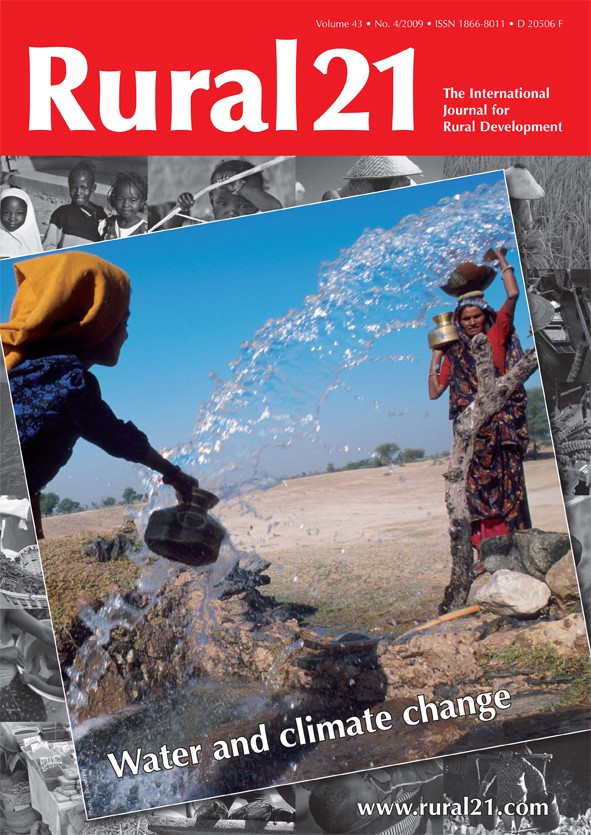Location
The international journal Rural 21 has dedicated more than 40 years to all topics surrounding rural development. Its ambition is to further those strategies and policies that strengthen rural areas of developing and newly industrialising countries and encourage their implementation. The journal addresses the complete range of relevant themes – from agriculture and fisheries via capacity building and education through to health and social security, energy supply and trade. Center-stage is always devoted to inquiring into how measures and strategies can contribute to global food security and to reducing poverty.
Rural 21 desires to further the dialogue between science and politics, the private sector, civil society and practitioners. Two platforms are designed for this purpose: Rural 21 in print is published four times a year, each issue highlighting a specific focus of rural development – this print edition is read in more than 150 countries. In parallel, Rural 21 online keeps the rural development community up to date on news and events, scientific findings and other print and online publications.
Rural 21 is published by DLG-Verlag GmbH in Frankfurt/Germany. Financial partners are BMZ (German Federal Ministry for Economic Cooperation and Development), GIZ (Deutsche Gesellschaft für Internationale Zusammenarbeit), DLG (German Agricultural Society – Deutsche Landwirtschaft-Gesellschaft), SDC (Swiss Agency for Development and Cooperation) and Helvetas Swiss Intercooperation.
The first issue of Rural 21 dates back to 1968. From 1974 to 2007, the journal was published in three languages entitled "entwicklung & ländlicher raum" / "agriculture & rural development" / "agriculture & développement rural". In 2008, the journal was relaunched as "Rural 21".
Members:
Resources
Displaying 241 - 245 of 319Water harvesting for home food security
Poverty in rural households have deepened in the past two years through world events: unprecedented rises in food and fuel prices were followed by global economic meltdown, all amidst growing climate uncertainty. Balancing water availability within and across growing seasons, water harvesting helps to buffer households against drought. Research on water harvesting in South Africa has focused on rural household livelihoods. Innovative results on appropriate water harvesting technologies and food security facilitation techniques are now being implemented in villages across South Africa.
Maize to help prevent night blindness
A team of German and Spanish scientists has genetically modified a maize plant in a way that markedly increases the level of three vitamins in the maize kernels. The level of betacarotene, the precursor to vitamin A, was raised by a factor of 169, the level of vitamin C increased six-fold and the level of folic acid, a vitamin of the B group, doubled.
Impact of climate change on the Nile river basin
The River Nile provides an invaluable source of livelihoods to over 160 million of people who dwell in its valley. The river valley is renowned for being a cradle of civilisation. As the populations grew and civilisation evolved, the demand for more water resources took a toll in the region. The more recent visible climate change effects have further compounded water management in the basin. Water and food security in the region is under threat, hence the need for robust transboundary water management. An effective institutional arrangement is a key factor in facilitating this process.
Foreign direct investments in land in developing countries
The world food crisis has spurred foreign direct investments (FDI) into arable land in developing countries. While significant financial inflows into agricultural sectors could be beneficial on a global scale, it could negatively affect local livelihoods. This article provides an overview of the different types of FDI in land. In addition, examples of investment flows are illustrated in an overview and a sustainable impact matrix outlines the occurring effects. Finally, requirements of avoiding negative effects are presented, to achieve a Pareto-efficient win-win situation.
Impact of melting glaciers in the Himalaya
The Himalayan region is not only tectonically active and ecologically fragile but is it also one of the most economically underdeveloped and most densely populated mountain ecosystems on the planet. These natural as well as human characteristics render the Himalayan region highly vulnerable to the impacts of development, degradation and climate change and in particular the impact of melting of glaciers and changes in the patterns of precipitation.


